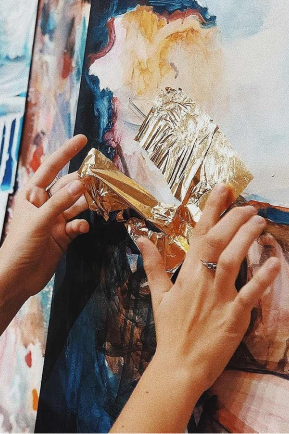If you’ve ever been mesmerized by the surface of a painting—the way it seems to ripple, crackle, or whisper—you’ve felt the power of texture. It’s one of the most underrated elements of art, yet it holds the key to transforming a flat surface into an immersive experience.
Let’s explore how texture works, how artists create it, and how you can begin using layering techniques to bring your work to life.
🎓 Ready to Become a Professional Artist?
Take your art and your life to the next level with the Milan Mastery Program ✨. Learn from world-renowned artists 🎨, master both classical and contemporary techniques 🖌️, and build a thriving art career doing what you love ❤️.
Apply now and start your journey to artistic mastery today 🚀.
What Is Texture in Art?
Texture refers to the surface quality of an artwork—how it feels or looks like it would feel. It can be:
- Actual (Tactile): You can physically feel it—thick paint, scratches, impasto.
- Visual (Implied): It looks textured through brushwork, layering, or illusion.
Both kinds contribute to a painting’s energy and depth, especially in abstract or expressive work.
Techniques for Building Texture
1 - Impasto
Thick applications of paint, applied with brushes or palette knives, create rich, sculptural surfaces. Think Van Gogh’s swirling skies or a bold abstract expressionist piece.
2 - Dry Brushing
Drag a dry brush loaded with minimal paint over the surface to reveal underlying layers or create a weathered effect. It’s perfect for subtle, atmospheric texture.
3 - Palette Knife Scraping
Use a palette knife to apply or scrape paint away, revealing underpainting or creating hard edges and ridges.
4 - Spray Paint & Unconventional Tools
Spray paint, sponges, scraping tools, or even your fingers can create unexpected surface effects. Don’t be afraid to experiment!
5 - Add Other Textures
Adding layers of gold leaf, molding paste, collage (paper and fabric). Try to integrate into your work using molding paste and gel medium, so that these additions feel embedded into the canvas.
Why Texture Matters
Texture invites the viewer to look longer, feel more, and explore the surface of your work. It can:
- Emphasize focal points
- Create a sense of movement or emotion
- Reflect the artist’s energy and process
Final Tip: Layering texture takes patience and practice. Try working in stages: start with washes, then build complexity over time. Let each layer guide your next move.
Want guided exercises? Download our FREE GUIDE & WORKBOOK for Mastering the 7 Elements of Art, or join our mastery program to explore texture, layering, and abstraction from the inside out.
Why Milan Art Institute?
Your Path to Artistic Mastery Starts Here
At the Milan Art Institute, we blend passion with expertise to help you unlock your artistic potential. Our Mastery Program and online art classes are designed for artists at all levels, providing step-by-step guidance and personalized support from seasoned professionals. Whether you're looking to refine your skills, discover new techniques, or build your artistic career, our courses offer the tools and insights you need. Join our vibrant community and transform your art journey with tailored instruction and a supportive environment.
/Student%20Work%20-%20Casey%20Wakefield%201.jpg?width=300&name=Student%20Work%20-%20Casey%20Wakefield%201.jpg)
